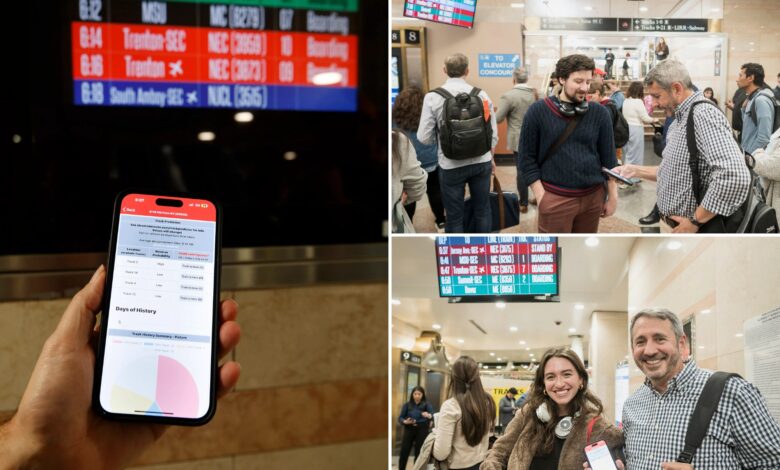NYC’s Clever Commute app is the ultimate Penn Station cheat code

This guy’s on the right track.
NYC commuters know well the anxiety-ridden moment when a train is finally called at Penn Station, minutes before departure — when otherwise typically civilized commuters often stampede like elephants down to the platform.
Longtime NJ Transit sufferer Joshua Crandall was fed up feeling the pent-up energy of his fellow stressed-out rail riders, standing around waiting — tired of the trample-or-be-trampled, chaotic mad dashes that inevitably followed.
So, the 59-year-old Montclair resident took matters into his own tech-savvy hands: He designed an algorithm to predict exactly which track the oft-unreliable New Jersey Transit and Long Island Rail Road trains will depart, well before any announcements.
“It’s not just a magic trick, it’s how you can beat the crowd,” Crandall, by day a financial tech worker in Manhattan, told The Post of his Clever Commute app — designed as a cheat code for escaping Gotham’s least-loved transit hub with your sanity.
The commuter of 30 years is not affiliated with NJT, the LIRR or Amtrak, but the public transport pro explained that after one particularly ghoulish go-home in the 2000s, he created Clever Commute. After he “wrote technology that ingests the departure board,” the app “can tell you right away which track this train has been on for the last 60 days.”
“It’s information many people don’t have handy,” he said of his pocket predictor, which offers premium service for a yearly $50 subscription. There are also nine ways to get it for free — Crandall said his primary focus is helping others.
The clever code-cracker started out by sharing his know-how via email blasts — eventually creating the first version of his app in 2015. Until recently, his expertise has been enjoyed by a relatively small circle.
Then, a few short weeks after NJ Transit’s historic cancellations and failures at Penn earlier this summer — and at a time where return to office mandates are almost a given — the conveyance connoisseur posted a promo for his product on social media.
The immediate response, he said, was “overwhelming.”
How does it work?
“Transit providers will say the tracks are announced 10 minutes in advance — spoiler alert, they’re not,” Crandall explained.
That inevitable standing around until too close to departure is what Clever Commute was designed to help users avoid.
To do that, the app’s algorithm pulls from two months of track history and uses what the way-home wizard called a proprietary technology that assigns “levels of probability” for certain tracks.
Besides providing average wait times based on past data, the app will rank possible track numbers in order of likelihood — even offering providing graphs and pie charts for geeky go-getters interested in more insider info.
However, Crandall warned, this is primarily a tool designed to put you at the top of the right staircase at the right time, ahead of the rush — not a green light to jump the starting gun completely.
That’s because the app can’t be right every time, he said — and an early descent to the wrong platform could mean a missed train.
Wait up top, however, and you’re nearly always at an advantage. If Clever Commute doesn’t 100% nail the location, it’s nearly always close, the conveyance connoisseur insisted.
“If the app calls 17 and the track is 18 — you’re still in the best spot,” Crandall offered.
The app also works with Metro-North and the LIRR at Grand Central Terminal — though that terminal rarely faces the same last-minute boarding announcements.
Penn Station’s uniquely close call times, Crandall said, are caused by Amtrak’s ownership of the tracks — and the national transit provider’s authority to “call the shots.”
Last Thursday evening, he could be found waiting in Penn Station during the evening rush — standing in the correct spot, naturally.
He used the time to help out a bewildered bystander, Brad Schuman, waiting for a 6:47 p.m. train — who was thrilled by Crandall’s accurate Track 7 call.
“To know where I’m going to go, and more importantly to beat this crowd, they’re like animals out there — I would love to use this every day,” Schuman told The Post.
This past Tuesday, Crandall was at it again and helped commuter Walter Reyes, who plainly said what every stressed-out commuter would think: “That will come in handy.”
And, even in cases of no dice, commuters still would rather have loved and lost.
“It was at least interesting to try,” William Whitehead said after the app missed his track on a night several trains were gunked up on standby.
And when the app was shown to train traveler Eliana Bass, she and her friend were slack-jawed.
When he accurately called Track 7 for a coincidental second time, Bass shouted, “Magic!”
The commandments of good commuting
As someone who has called Penn Station a second home for three decades, Crandall knows every nook and cranny — and has witnessed every human behavior imaginable.
Here are some of his tips for a less-terrible commute.
- There are no bonus points for showing up to Penn Station early. Trains seldom arrive ahead of schedule. Kill time somewhere less terrible.
- There are easy online resources to better understand the anatomy of Penn’s confusing labyrinth. Use them to find less-trafficked pathways to your destination.
- Usually, the front of the train has the most open seats. Also, if there’s a quiet car, opt for it — and respect the cardinal rule.
- Get noise-reducing headphones and also bring water, as dehydration can lead to heightened irritability.
- Dress in layers in case a train is either unseasonably hot or cold — you never know which it will be.
- Use Penn alternatives if you can — hop the PATH to the historic NJ Transit terminus in Hoboken for NJT, or choose Grand Central or Atlantic terminals for the LIRR.




